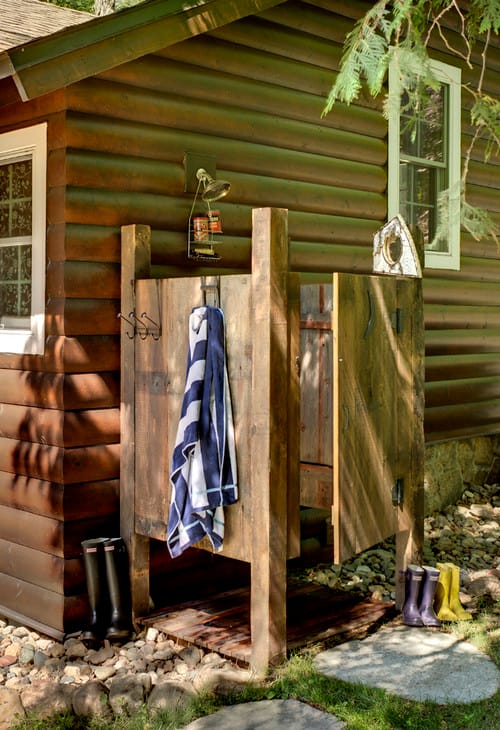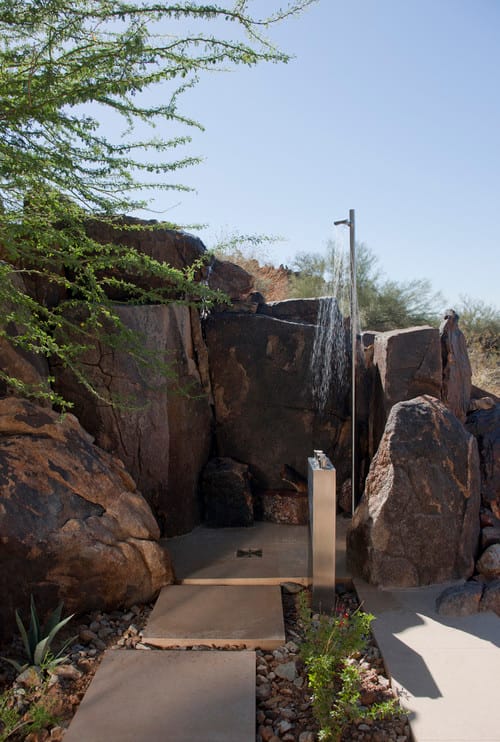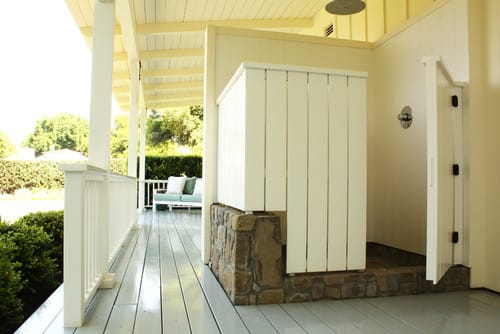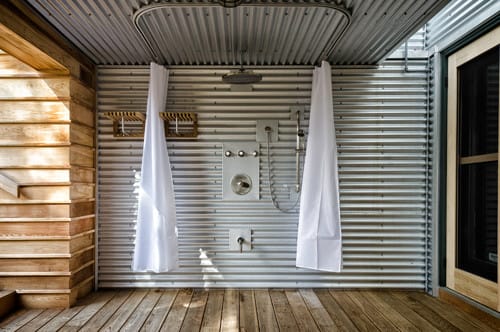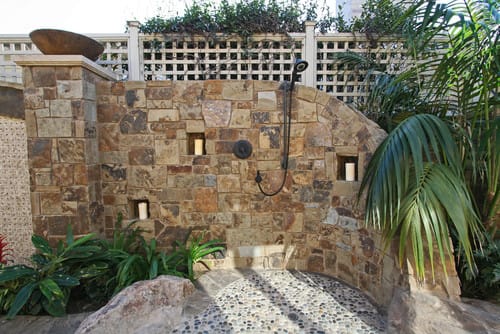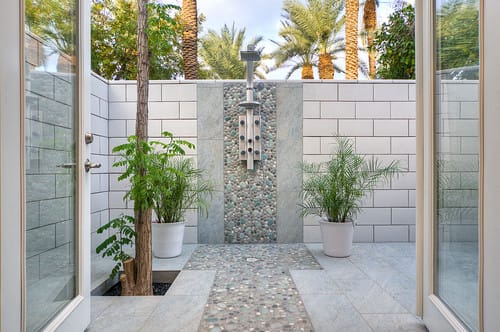How to Design an Outdoor Shower
Outdoor showers are most often found in homes that are on the beach or homes with swimming pools.
This certainly makes sense for conveniently rinsing off after surfing or swimming before entering the house, but you do not have to live by the ocean or have a pool to enjoy a little al fresco bathing.
In fact, with the beautiful, warm weather we enjoy in the San Diego County and Orange County areas, this might be something you would like to make part of your daily routine.
Once considered an exterior feature found primarily in high-end homes, outdoor showers are now an affordable luxury that almost any homeowner can consider for their backyard.
As long as you have the space and enough privacy — and you live in a neighborhood that allows them — you can have some sort of outdoor shower, regardless of your budget.
Let’s start with some things to consider when designing your shower.
Outdoor Showers: Twelve Things to Consider
The best way to ensure a satisfactory end product is to take the time for proper planning and making sure the job is completed correctly.
Here are twelve things to consider to get your outdoor shower project off to a good start.
1. If your patio shower is going to have plumbing, you are going to need a plumbing permit. While it is possible to complete projects without the proper permits, it is not a good idea. It could result in you having to disclose the unpermitted structures when selling your home, having to remove unpermitted structures and paying fines.
2. Depending on your shower design, you might need additional permits. If you are working with a licensed contractor (which you should), he or she will be able to handle the permit process for you or walk you through it.
3. Have your contractor or your favorite plumber assess your current water heater situation to make sure the unit you have can handle the addition of a shower to the system.
4. Some municipalities, homeowners associations and CC&Rs do not allow outdoor showers, so check with any bodies that govern your area to make sure this home improvement project is an option.
5. When choosing a location for your shower, try to find a spot that gets direct sunlight. This is better for drying things out quickly, ensuring enough light without having to add a light fixture, and making for a warmer and more enjoyable experience when showering outdoors.
6. If you plan to use the shower after dark, you will need to include lighting in your design and will need a permit if you need to run electricity to the area.
7. It can be tempting to place your patio shower on the exterior of your house, particularly if plumbing and electricity is already in the wall nearby. However, some exterior materials are not meant to endure that much water on a regular basis. This is particularly true of some wood products, which will wear quicker in the area of your shower than other areas of your home. It is generally best to either install the shower on the side of your house during the original build or a larger renovation project where you are also replacing the siding — or picking another spot for your shower.
8. Before you design your shower, you need to consider how private or open you want it. If you have nearby neighbors, ensuring privacy is going to be an important part of the design process.
9. Proper drainage is incredibly important when installing a shower. It is best to bring in a professional to assess the current grading and make any necessary changes before installation begins.
10. An outdoor shower is a great opportunity to reclaim your shower water for use in the garden. With an outdoor shower, you do not necessarily need a complex greywater system to make this happen. You can often use gravity to move the water from your shower to nearby planters or grass. Your grading contractor or a greywater systems professional will be able to help you come up with a plan that works for your backyard and the location of your shower.
11. There are several flooring options for outdoor showers, including concrete, wood, bricks, pebbles and paving stones. Unless you are working with an already existing surface, slip-resistant paving stones are an ideal choice that can make your shower floor safer when wet.
12. Keep in mind that your open-air shower will be out in the elements continuously. This means indoor options may not work as well outdoors. For example, you will need to find rust-resistant fixtures, and if you use a shower curtain, make sure it is made from fabric made for use outdoors.
How to Create Privacy for an Outdoor Shower
Privacy is particularly important if you have nearby neighbors, but it is also important if you plan to use your shower regularly while friends or family members might be enjoying other parts of your outdoor living areas.
This is especially true if you plan on doing more than rinsing off while donning your bathing suit after swimming or surfing.
When planning for a private shower experience, consider all possible vantage points.
This could include second-story windows or balconies in your own home or your neighbors’ homes.
Here are seven ways to increase privacy around your shower:
1. An old-fashioned shower curtain will work just as well outside as they do inside and provides a way to add color and a bit of whimsy to your shower experience.
2. Installing a trellis and planting fast-growing vines is a nice way to naturally increase privacy and beautify your outdoor living area.
3. A partial wall makes sure your most important parts are covered while allowing ample natural light to flood your shower area.
4. A full wall is a better option if you plan on using your outdoor shower as your primary bathing option or at least plan on using it regularly for this purpose. This also allows you to create a bathing situation that is more similar to the indoor options with which we have become accustomed, which may make the transition to showering outside easier.
5. Tucking your shower into an existing corner is a great way to create privacy and better use the available space in your yard.
6. Planting shrubs or trees with lots of foliage around your shower is another natural way to increase privacy.
7. A fully enclosed tent-like structure is a good choice for those who want complete privacy when showering outside.
Stocking Your Outdoor Shower
Part of creating the ideal al fresco bathing situation is making sure your patio shower is properly fitted and stocked with the essentials.
A towel bar or hooks is a must if you want to make sure your towel or robe is close at hand.
If multiple people will be using the shower, you may want to include multiple hooks to make sure everyone has somewhere to hang their towels — and they do not end up draped over your patio furniture.
If you have dogs, you may want to consider installing a handheld shower head.
If your primary or secondary shower head is handheld, washing your dogs outside will be much more convenient and more comfortable for both of you.
They are sure to particularly appreciate taking a bath with warm water.
You will also want a convenient place to keep shower supplies, such as soap and shampoo, without needing to set it on the ground or having it out for your guests to see when you are entertaining in other areas.
A simple shelf works great for this and can be seamlessly included in your design if you are working with an experienced contractor.
If you are planning on reclaiming the water and using it for landscaping purposes, make sure you purchase soaps and shampoos that are bio-degradable, natural and safe for plants.
If you plan to use your patio shower for daily bathing, you may also want to include a small bench in the design to make things like shaving legs more convenient.
Outdoor Showers: Other Considerations
Open-air showers are no longer a luxury, and a functioning shower can be had on any budget.
Patio showers can be as simple as a hose hooked to an existing faucet and attached to a tree or fence, or they can be just as intricate and luxurious as the finest indoor shower you have ever seen.
It all depends on your personal style, your budget, what is allowed in your area and the space you have available.
Of course, before you go too simple, you do need to think about whether or not you will regularly use a shower that only offers cold water.
If you want hot and cold water, which is a very good idea, you are going to need to install your shower where there is existing plumbing in the wall or run plumbing to the area.
You also do not need much room.
With a little creativity, a shower can be tucked in to a corner of an existing paving stone patio, near your pool or elsewhere in your yard where a few feet of space is available.
Choosing the materials for your shower is really where the fun begins.
There are so many options from which to choose and such creative ideas you can use for inspiration that you are really only limited by your imagination — or, in some cases, maybe a little by your budget or building codes as well.
Rustic wood, tile, river rock, paving stones, bricks, travertine, corrugated metal, turfstone, bamboo and vinyl fencing are just a few of your options, and you should have no trouble finding the right materials to make your open-air shower complement the architecture of your home and your landscaping design.
Lastly, while you are determining whether regular outdoor showering is for you, you might also want to consider the idea of an outdoor bathtub.
The thought of relaxing in a warm bath under the stars may just be enough to convince you that you also need a bathtub on your patio.
Your Turn…
Do you have an outdoor shower? How did you make it fit in with your overall landscaping design?
